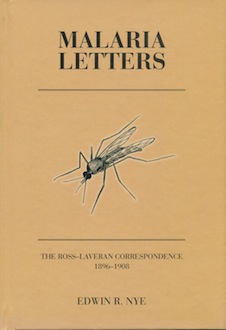The Ross–Laveran correspondence 1896–1908
Edited by Edwin R. Nye
 The book
The book
Alphonse Lavern first demonstrated the parasitic nature of malaria in 1880. Within twenty years the role of mosquitos in transmission had been worked out by Ronald Ross. This first translation of the two scientists' correspondence asks whether the world has let them down, by failing to translate their findings into 'straightforward action'.
It has been estimated that every thirty seconds a child dies from malaria somewhere in the world. New cases of the disease affect more than one hundred million people each year, most of them in sub-Saharan Africa. But with global warming the distribution of mosquito vectors is changing and whole populations are at increasing risk. Alphonse Laveran first demonstrated the parasitic nature of malaria in 1880 and within twenty years the role of mosquitoes in transmission had been worked out by Ronald Ross. This first translation of the two scientists' correspondence asks whether the world has let them down, failing to translate their findings into 'straightforward action'.
This book places modern science in a broader historical context, inviting the reader to both share the excitement of a major scientific discovery and to ask pressing questions about the application of such findings.
The editor
EDWIN R. NYE was born in Belgium and received his early education in France. He taught at the London School of Hygiene and Tropical Medicine before joining the staff of the Otago Medical School. He holds an ONZM for services to medicine and the community. He is the co-author with Mary Gibson of Ronald Ross; Malariologist and Polymath: A biography (1997).
Publication details
Hardback, 215 x 145 mm, 62 pages, colour images, ISBN 978 1 877372 66 7, $45
2010
OUT OF PRINT